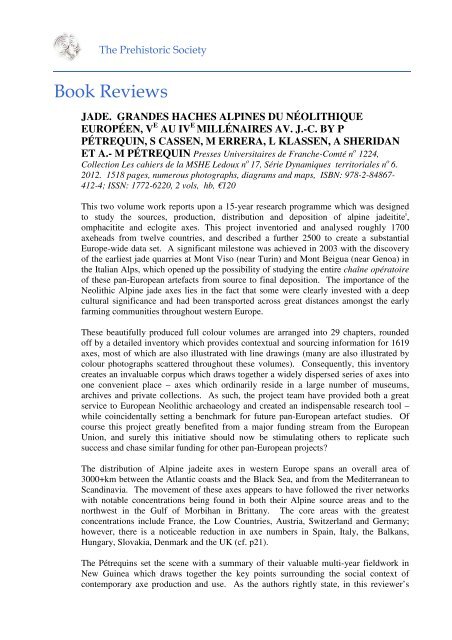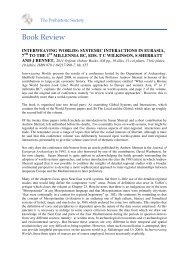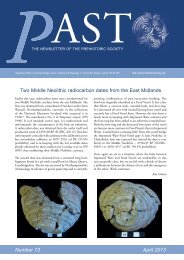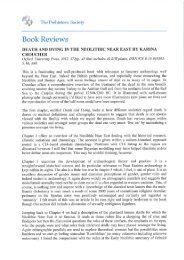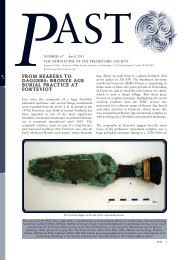Jade. Grandes haches alpines du Néolithique européen,. Ve au IVe ...
Jade. Grandes haches alpines du Néolithique européen,. Ve au IVe ...
Jade. Grandes haches alpines du Néolithique européen,. Ve au IVe ...
You also want an ePaper? Increase the reach of your titles
YUMPU automatically turns print PDFs into web optimized ePapers that Google loves.
The Prehistoric Society<br />
Book Reviews<br />
JADE. GRANDES HACHES ALPINES DU NÉOLITHIQUE<br />
EUROPÉEN, V E AU IV E MILLÉNAIRES AV. J.-C. BY P<br />
PÉTREQUIN, S CASSEN, M ERRERA, L KLASSEN, A SHERIDAN<br />
ET A.- M PÉTREQUIN Presses Universitaires de Franche-Comté n o 1224,<br />
Collection Les cahiers de la MSHE Ledoux n o 17, Série Dynamiques territoriales n o 6.<br />
2012. 1518 pages, numerous photographs, diagrams and maps, ISBN: 978-2-84867-<br />
412-4; ISSN: 1772-6220, 2 vols, hb, €120<br />
This two volume work reports upon a 15-year research programme which was designed<br />
to study the sources, pro<strong>du</strong>ction, distribution and deposition of alpine jadeitite i ,<br />
omphacitite and eclogite axes. This project inventoried and analysed roughly 1700<br />
axeheads from twelve countries, and described a further 2500 to create a substantial<br />
Europe-wide data set. A significant milestone was achieved in 2003 with the discovery<br />
of the earliest jade quarries at Mont Viso (near Turin) and Mont Beigua (near Genoa) in<br />
the Italian Alps, which opened up the possibility of studying the entire chaîne opératoire<br />
of these pan-European artefacts from source to final deposition. The importance of the<br />
Neolithic Alpine jade axes lies in the fact that some were clearly invested with a deep<br />
cultural significance and had been transported across great distances amongst the early<br />
farming communities throughout western Europe.<br />
These be<strong>au</strong>tifully pro<strong>du</strong>ced full colour volumes are arranged into 29 chapters, rounded<br />
off by a detailed inventory which provides contextual and sourcing information for 1619<br />
axes, most of which are also illustrated with line drawings (many are also illustrated by<br />
colour photographs scattered throughout these volumes). Consequently, this inventory<br />
creates an invaluable corpus which draws together a widely dispersed series of axes into<br />
one convenient place – axes which ordinarily reside in a large number of museums,<br />
archives and private collections. As such, the project team have provided both a great<br />
service to European Neolithic archaeology and created an indispensable research tool –<br />
while coincidentally setting a benchmark for future pan-European artefact studies. Of<br />
course this project greatly benefited from a major funding stream from the European<br />
Union, and surely this initiative should now be stimulating others to replicate such<br />
success and chase similar funding for other pan-European projects?<br />
The distribution of Alpine jadeite axes in western Europe spans an overall area of<br />
3000+km between the Atlantic coasts and the Black Sea, and from the Mediterranean to<br />
Scandinavia. The movement of these axes appears to have followed the river networks<br />
with notable concentrations being found in both their Alpine source areas and to the<br />
northwest in the Gulf of Morbihan in Brittany. The core areas with the greatest<br />
concentrations include France, the Low Countries, Austria, Switzerland and Germany;<br />
however, there is a noticeable re<strong>du</strong>ction in axe numbers in Spain, Italy, the Balkans,<br />
Hungary, Slovakia, Denmark and the UK (cf. p21).<br />
The Pétrequins set the scene with a summary of their valuable multi-year fieldwork in<br />
New Guinea which draws together the key points surrounding the social context of<br />
contemporary axe pro<strong>du</strong>ction and use. As the <strong>au</strong>thors rightly state, in this reviewer’s
opinion, despite ethnographic analogy being relatively unfashionable at present, there is<br />
still much that can be gleaned from targeted ethnographic observation focussing upon<br />
process, context, use and meaning. In New Guinea the use of polished axes was found to<br />
be multi-faceted. They can define wealth and status, be used in gift exchange and for<br />
marriage and death payments (as many readers will be familiar), they are used in rituals<br />
designed to communicate with the spirit world – and some are used to fell trees and be<br />
offensive weapons! With such a wide-ranging functionality for a single tool type, it is<br />
unsurprising that indivi<strong>du</strong>al axes can accumulate huge prestige and symbolism,<br />
developing their own biography, and as a direct result the craft specialists who pro<strong>du</strong>ce<br />
these artefacts are considered powerful socially, particularly as their raw material is<br />
viewed as part of the fabric of origin stories. In addition to regular forms of axe (both<br />
functional and ceremonial), the New Guineans also craft oversized axes (ye-yao) which<br />
are then anthropomorphised by being dressed with yellow orchid fibres and strips of fur<br />
from the tree kangaroo; such artefacts are often used as marriage payment.<br />
Consequently, in New Guinea, certain axes are given a great cultural value which allows<br />
them to be transported across political boundaries, and they play a pivotal role in the<br />
processes of social repro<strong>du</strong>ction and renewal. They are also potent material symbols of<br />
male competition.<br />
As mentioned above, some of the sources of Alpine jades were first identified in 2003<br />
using spectroradiometry, x-ray diffraction and petrographic thin sectioning. The first, in<br />
the Mont Viso massif, occurred at altitudes ranging between 1500-2400m above sea level<br />
and comprised five sources. Certain sources, such as a huge boulder at Peyronel lying at<br />
an altitude of 2310m (p71), or the blocks at the col of Murel (2380m; p77-97), exhibited<br />
thermal cracks providing evidence of fire-setting as part of the extraction process at these<br />
locations. Flakes also displayed thermal damage at Barant (p79), all suggesting the<br />
regular use of this extraction technique across the area. The lower slopes of these<br />
mountains, particularly to the south following the stream network, were littered with<br />
knapping debris and the occasional axe hoard. The col of Murel was also notable for a<br />
rock shelter which was located near the break of slope which dropped in to the valley of<br />
Bulè (p83-5). Here a small axe roughout was discovered beneath the overhang and set<br />
vertically with its cutting edge upwards, alongside a serpentine plaque, clearly an<br />
example of a ritualised hoard reminiscent of the axes planted vertically at the foot of<br />
Breton standing stones. The second jade source was found in the Mont Beigua area, but<br />
processes of ravine formation have impacted badly upon the survival of extraction and<br />
pro<strong>du</strong>ction sites and only a few primary sources of jadeitite, eclogitic and amphibolitic<br />
rocks were discovered. The <strong>au</strong>thors make it clear that other jade sources probably remain<br />
to be discovered in this part of the high Alps which geological studies have shown<br />
contain the majority of the sources of Alpine jades. A superbly illustrated inventory of<br />
quarry sites and find spots is presented between pages 55-170.<br />
Despite the success of identifying some of the jade sources in the Viso and Beigua<br />
regions, some artefacts have so far escaped sourcing such as the nephrite axes and chisels<br />
which may have originated in the Valais, and were then fed into the Mont Viso<br />
distribution network. Some of these pro<strong>du</strong>cts then travelled not only to the inevitable<br />
Carnac area (Brittany) , but also to Hopton in East Anglia (UK) and to deposition in rich<br />
assemblages such as that from the tomb at Ripollet in Barcelona (Spain) where a sawn<br />
nephrite axe was discovered alongside flint (from V<strong>au</strong>cluse) and obsidian lithics and a<br />
variscite bead necklace (p196-199). It is thought that these nephrite pieces were created<br />
as imitations of the classic ‘Alpine jade’ axes, and that their makers then simply made<br />
good use of the pre-existing distribution networks (p201).
The Mont Viso extraction area is the highest point in the southern Alps, spanning a range<br />
of high mountain terrains which can make movement testing at times, and the location of<br />
the extraction sites suggests that those using the sources could only have done so <strong>du</strong>ring<br />
the summer months when the high alpine pastures were snow-free. However, the<br />
extremes of climate and rapidly changing weather patterns would also have made jade<br />
extraction a challenge at any time of year, particularly as most sites are located between<br />
1500-2400m above sea level, and these difficulties must have added to the mythology<br />
surrounding these axes. A series of 16 trial trenches provided charcoal used to date the<br />
episodes of extraction in the Mont Viso area which suggests that the main phase of<br />
exploitation occurred between 5500-3700 cal BC, with a peak represented between<br />
c.5250-4300 cal BC - although this could simply reflect sampling bias (cf. p231, fig 27).<br />
In the Upper Bulè Valley, one of the key extraction areas became known as the Cercle<br />
des Blocs, characterised by a random grouping of massive boulders which provided a<br />
series of three rock shelters (cf. p220, fig 10). Three sondages recovered evidence for the<br />
final stages of roughing out at this site, and the project team was able to identify that the<br />
sources for the raw material were generally less than 400m distant (cf. p243, fig 45),<br />
although some material had travelled to this site from the Alpetto-Murel area and the<br />
Upper Porco Valley, a distance of some 1-3km. The rock types exploited here included<br />
jadeitite, omphacitite, eclogite and amphibolite, and the extraction was undertaken with<br />
fire-setting. From the evidence of the debitage recovered from the sondages at the Cercle<br />
des Blocs it would appear that Bégude type axes - the earliest form of axe - appeared first<br />
around 5000 cal BC, followed by the Durrington, then the Puy type last of all. All three<br />
types were also pro<strong>du</strong>ced together and in similar quantities between 4499-4344 cal BC<br />
(cf. p232, fig 29). The <strong>au</strong>thors present a series of reasoned arguments as to why this was<br />
a special area, culturally, and of great importance to those exploiting the jades, which led<br />
to ritualised extraction (roughouts set with cutting edge upright; cup-marked rock art) to<br />
create pro<strong>du</strong>cts which then underpinned the perceived social inequalities apparent in the<br />
rich assemblages or hoards containing jade artefacts (p251-253). This reviewer found it<br />
difficult to argue against these conclusions.<br />
The <strong>au</strong>thors have also undertaken experimental work to gain a greater understanding of<br />
pro<strong>du</strong>ction techniques. Consequently it is now known that the larger axeheads, deemed<br />
to have been ‘socially valourised’, were knapped from large flakes quarried by firesetting.<br />
Sawing (using thin pieces of wood with sand as an abrasive) was used to shape<br />
preforms from the mid-5 th millennium. Interestingly, from experiments with hafts it was<br />
demonstrated that initially the Alpine blades were hafted as adzes, but when they reached<br />
the Morbihan they were re-polished and re-hafted as axes which led ultimately to their<br />
incorporation as a motif in Breton rock art. The term ‘socially valourised’, as used by the<br />
project team, is designed to differentiate between utilitarian axes and those deemed<br />
culturally important, or prestige goods as they were known in the 1970s. The criteria for<br />
determining such valourised axes is that they are not generally found in settlements but<br />
rather occur as stray finds, generally in pairs set in the earth with the cutting edges<br />
upwards (at rock shelters, rivers, bogs, caves, and at other Alpine locations). Many also<br />
remained in circulation as part of the paraphernalia used to legitimise various elites or<br />
ritual/ceremonial practitioners. Some axes were perforated for wearing as axehead<br />
pendants in France after 3200 cal BC - until they ultimately end their uselife in a<br />
mortuary deposit as the final materialisation of social context and personhood, as, for<br />
example, epitomised by the magnificent assemblage from Mané er Hroëck (p946-953).<br />
The parameters which the project adopted was to focus upon a pan-European contextual<br />
review of those Alpine axes that are, or were, over 13.5cm long, amounting to a corpus of<br />
1764 examples ii . A chronological sequence was discovered, starting with the earliest
Bégude type from the beginning of the 5 th millennium, followed by the Carnac axeheads<br />
from the Morbihan region around the mid-5 th millennium, until the late 5 th /early 4 th<br />
millennium when the distribution is typified by hoards such as Altenstadt. The final form<br />
of Alpine axe was the Puy type, which spread across most of Europe but was a harbinger<br />
of the decline in Alpine axe pro<strong>du</strong>ction and the gra<strong>du</strong>al re-focussing back to the<br />
pro<strong>du</strong>ction of more functional axeheads. Interestingly, the chronology and distribution of<br />
Alpine axes also illustrates a buffering of two competing artefact distributions, jade in the<br />
west and copper/gold in the east, although neither area was totally exclusive, particularly<br />
in the Balkans and the Black Sea catchment (cf. p584-5). A fine example of this material<br />
and cultural interaction is the assemblage from Tomb 43 at Varna II (Bulgaria) which<br />
included two Mont Beigua Alpine axes which had been reworked and re-polished into<br />
skeuomorphs of Varna type copper axeheads – a clear case of ‘re-branding for the<br />
local/regional consumer’.<br />
The statistical analysis of the dimensions of the corpus of axeheads has demonstrated the<br />
existence of regional types based upon length, width and thickness; profile and shape are<br />
also fundamental characteristics. The cross sections of the axes range from rectilinear<br />
forms through ovoids to lozenge-like. Of the four major typological groups of axes<br />
which dominated Europe <strong>du</strong>ring the 5 th and part of the 4 th millennium iii , three have a<br />
strong geographical preference. The main raw material in the majority of continental<br />
Europe was invariably jadeitite, which rose from some 28% of the total of jade-related<br />
rocks at the beginning <strong>du</strong>ring the Bégude phase axes to a peak of 96% around 4500 cal<br />
BC <strong>du</strong>ring the Tumiac and Altenstadt/Greenlaw phase, before tailing off to a more<br />
modest 53% at the time of the final Puy axes around 4000 cal BC (cf. p630). In Italy, in<br />
contrast, eclogites and other rocks dominated; jadeitites began at 11% but only peaked at<br />
23% around 4200 cal BC with the Chenoise and Durrington types, before re<strong>du</strong>cing to<br />
21% <strong>du</strong>ring the final Puy phase. Considering the geographical proximity of the Alpine<br />
sources it is curious why the bulk of the Italian peninsula did not see significant southerly<br />
movements of axes, unless the presence of the flint mines of the Gargano peninsula<br />
proved a more dominant cultural factor in axe distributions?<br />
The wider impact of Alpine jade axes across Europe is highlighted by the occurrence of<br />
imitations of Carnac type axes (particularly Tumiac and Saint-Michel types) copied in<br />
local rocks following the appearance of small numbers of originals from the Carnac area<br />
into local networks. Consequently we find copies of Carnac axes crafted in flint in<br />
Denmark and the Paris Basin, sillimanite was used in Spain and serpentinite in<br />
Switzerland. In addition, as Alison Sheridan has suggested here and elsewhere, the green<br />
Seathwaite Tuff of the Group VI axes from Langdale (Cumbria) may have been chosen<br />
for its colour/textural similarities to the green jades following the appearance of Alpine<br />
jade axes into the UK.<br />
The intro<strong>du</strong>ction of jade axes into the UK, from a typo-chronological perspective, cannot<br />
have occurred earlier than 4300-4200 BC, and the likely route was probably via<br />
Normandy and the Pas-de-Calais. However, the earliest recorded examples from secure<br />
contexts are the axes/axe fragments discovered from the Sweet Track (Somerset) and<br />
Cairnholy I (Dumfries and Galloway) which were deposited around c.3800 BC.<br />
Interestingly, this was a time when Alpine axes had gone out of use in France and<br />
Belgium. Axe pendants then appear to have been intro<strong>du</strong>ced <strong>du</strong>ring 3200-2800 BC,<br />
demonstrating a two stage intro<strong>du</strong>ction of Alpine artefacts into the UK. The delay in the<br />
initial intro<strong>du</strong>ction of jade axes is borne out in the archaeological record: none of the<br />
earliest Bégude type axes have so far been discovered in the UK, although there are two<br />
axes (Breamore, Hants; Coddington, Notts) which may originally be re-worked and re-
polished examples of this type. Of the larger axeheads the Altenstadt/Greenlaw type is<br />
the most numerous (42%), followed by Durrington (22%), Puymirol (10%) and<br />
Glastonbury types (9%); the least common are the Chelles and perforated Tumiac forms<br />
(both types 1%). The most common smaller axes are the Durrington type (42%),<br />
followed by Chelles (30%) and Puy types (19%).<br />
The book is rounded off by interesting speculation concerning the social role of Alpine<br />
jade axes in Neolithic Europe and their demonstrably special place in society. The fact<br />
that this project has discovered robust criteria to differentiate culturally significant<br />
artefacts from the mundane (there were also functional jade axes and adzes), has<br />
pro<strong>du</strong>ced a more rounded view of the mechanisms, circulation and meaning embedded in<br />
this aspect of Neolithic material culture. This has allowed the <strong>au</strong>thors to sketch the social<br />
context of the hierarchical and structured deposition of these rare iconic oversized<br />
‘tools’ iv and their symbolic value to contemporary societies. Clearly the role played by<br />
the Carnac region in stimulating the movement and ‘valourisation’ of Alpine axes was<br />
pivotal. Here the axes were at times burnt or broken at deposition, featured in tomb art<br />
and on stelae, and were circulating between elite sections of society as part of social<br />
renewal or mortuary ceremonialism within the context of the emergence of ‘megalithism’<br />
and other novel aspects of ritual or ceremonial architecture. Consequently the Alpine<br />
jade axe became a widespread symbol of elite or special uses which was transmitted and<br />
adopted – often in modified (or imitated) ways - across much of Europe.<br />
If this reviewer was to be at all critical, it would be to bemoan too few plans of the quarry<br />
sites and working areas. However, this is a minor issue as these sites are fully illustrated<br />
by photographs, and the volumes are well illustrated throughout by a series of wonderful<br />
distribution maps, explanatory diagrams, artefact photographs and the myriad drawings<br />
of axes. If you are at all interested in Neolithic material culture, then my<br />
recommendation would be to buy or borrow these books, they are ground-breaking.<br />
They are a mine of information which will be quarried for years to come (all puns<br />
intended), and include such diverse data as the 14 C chronology of French flint mines, the<br />
location of the fibrolite sources in Brittany, and so much more! Tout simplement ce livre<br />
est magnifique – félicitations à toutes les <strong>au</strong>teurs.<br />
Peter Topping<br />
Newcastle University<br />
Review submitted: October 2012<br />
i <strong>Jade</strong>itite is used by the project team in preference to the often cited ‘jadeite’ as the former term is considered to<br />
more accurately describe the rock type. <strong>Jade</strong> is the collective term for all of the rock types in this study, i.e.<br />
jadeitite, omphacitite, and eclogite.<br />
ii The size of axes appears to diminish the greater the distance from the Alpine quarries. Some of this will reflect<br />
fashion/preference or trends, but some examples will also illustrate processes such as recycling, or re-working after<br />
breakages. Such processes of re<strong>du</strong>ction are epitomised by miniature axes, such as the example from Kercado<br />
(Carnac) which is only 3cm in length (cf. p582), similar sized examples from Provence and the Adriatic (e.g. p760-<br />
766), the Preston and Wooton Fitzpaine (both Dorset) miniature axe pendants of 5cm length (p 1051), or the tiny<br />
2cm long miniature adze blade from Be<strong>au</strong>lieu, Hants (p 1053).<br />
iii The ‘Southern Group’ comprising Bégude and P<strong>au</strong>ilhac types; the ‘Carnac Group’ of Bernon, Saint-Michel and<br />
Tumiac; the ‘Northern Group’ of Altenstadt/Greenlaw and Chenoise types; and finally the ‘Ubiquitous Group’<br />
consisting of Durrington and Puy types.
iv To illustrate the oversized nature of many non-functional jade axes one only needs to consider the epitome of such<br />
gigantism – the huge Mané er Hroëck (Locmariaquer, Morbihan) axe which has a length of 46.6cm.<br />
The views expressed in this review are not necessarily those of the Society or the Reviews Editor


